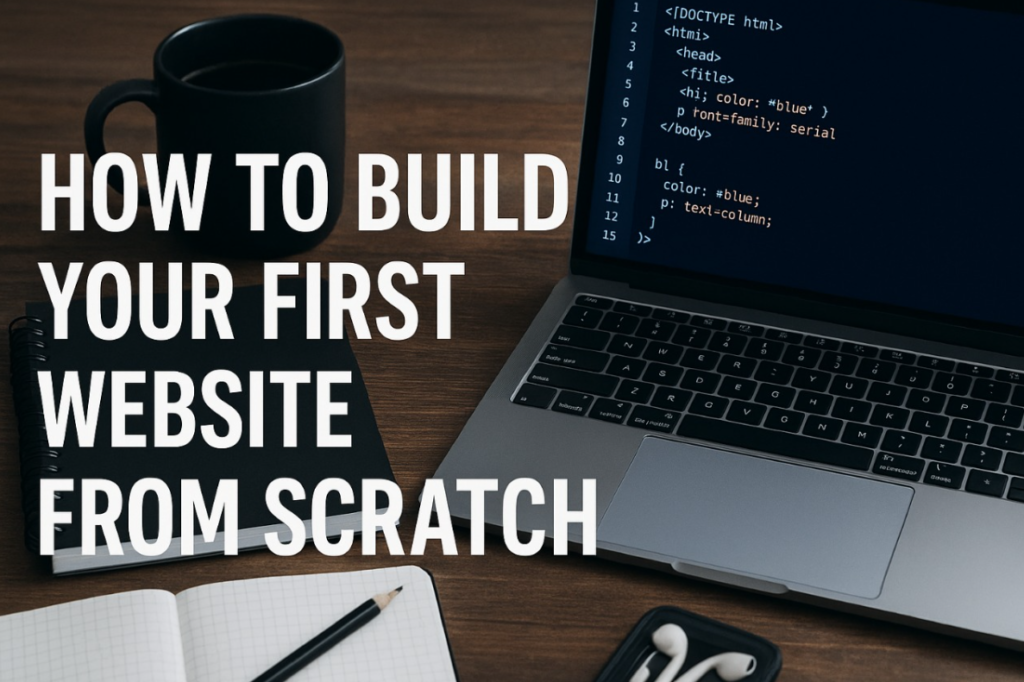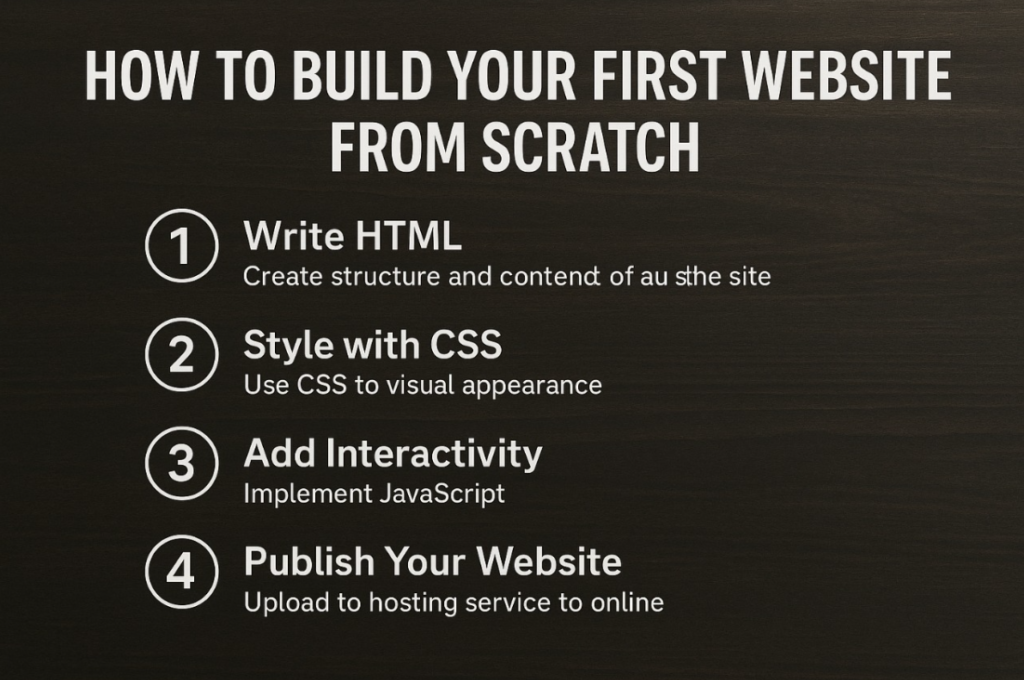
Table of Contents
- How to Build Your First Website from Scratch
- Introduction
- Planning Your Website
- Choosing the Right Tools
- Picking a Platform
- Designing Your Website
- Developing Your Site
- Adding Content
- SEO Essentials
- Testing Before Launch
- Going Live
- Maintaining Your Website
- Tips for a Successful Website
- Common Mistakes to Avoid
- Conclusion
- FAQs
Introduction
Why Building a Website is Easier Than Ever
Back in the day, creating a website meant memorizing HTML and hoping your code didn’t crash your browser. But today? It’s like baking from a mix—most of the ingredients are already prepared for you.
Who This Guide is For
Whether you’re a student, entrepreneur, blogger, or someone just curious, this guide is for you. No tech wizardry required—just a bit of patience and creativity.
Planning Your Website
Define Your Purpose
Ask yourself: “Why am I building this site?”
Portfolio? Blog? Business? Clear goals help you stay focused and make decisions easier down the line.
Know Your Audience
You wouldn’t speak to teenagers the same way you’d address CEOs, right? Knowing who you’re talking to shapes your content and design.
Map Out Key Pages
Every site needs a structure:
- Home
- About
- Services/Portfolio
- Contact
- Blog (optional)
Sketch it out on paper or use free tools like Whimsical or Miro.
Choosing the Right Tools
Domain Name & Hosting
What is a Domain?
Your domain is your web address—like yourname.com. Choose something simple, brandable, and easy to remember.
What is Web Hosting?
Hosting is where your website files “live.” Think of it like renting space on the internet. Some reliable hosts: Bluehost, Hostinger, SiteGround.
Website Builders vs. Manual Coding
Beginners? Website builders like Wix or Squarespace are drag-and-drop simple.
Want full control? Go the manual route with HTML/CSS/JavaScript. You’ll have a steeper learning curve but more power.
Picking a Platform
WordPress
It powers 43% of the web. It’s flexible, beginner-friendly (especially with page builders like Elementor), and has a huge community.
Wix, Squarespace, and Other Builders
If you want fast results without coding, these are great options. Just pick a template, customize, and go.
HTML/CSS/JavaScript for Manual Builds
Feeling brave? Start coding from scratch. Use:
- HTML for structure
- CSS for style
- JS for interactivity
Use VS Code as your editor and GitHub Pages or Netlify for free hosting.
Designing Your Website
Themes and Templates
Most platforms offer pre-made designs. Choose one close to your vision and tweak from there.
Mobile Responsiveness
60%+ of traffic is mobile. Your site must look good on phones and tablets.
Branding and Colors
Pick 2-3 main colors. Use them consistently. Add your logo. Stick to 1-2 fonts.
Developing Your Site
Basics of HTML
Use tags like:
htmlCopyEdit<h1>This is a heading</h1>
<p>This is a paragraph</p>
<a href="https://example.com">Link</a>
Styling with CSS
Example:
cssCopyEditbody {
font-family: Arial;
background-color: #f0f0f0;
}
Adding Interactivity with JavaScript
Example:
javascriptCopyEditdocument.getElementById("btn").onclick = function() {
alert("Hello World!");
}

Adding Content
Writing Engaging Copy
Speak like a human. Be clear, concise, and compelling. Use short paragraphs and bullet points.
Using Images and Videos
Visuals break up the monotony. Use tools like Canva for graphics, Unsplash for free photos.
Structuring Blog Posts or Landing Pages
Use headings (H1, H2, H3), bold important info, and include CTAs (calls-to-action) like “Contact Me” or “Learn More.”
SEO Essentials
On-Page SEO Basics
Include keywords naturally in titles, meta descriptions, and throughout your content.
Metadata and Alt Text
Use descriptive meta tags and always add alt text to images for accessibility and SEO.
Link Building and Site Structure
Link to internal and external resources. Create a logical structure with clean navigation.
Testing Before Launch
Browser and Device Testing
Use tools like BrowserStack to test your site on Chrome, Firefox, Safari, mobile, tablet—you name it.
Speed and Performance Checks
Use Google PageSpeed Insights or GTmetrix. Compress images. Use lazy loading.
Debugging Common Issues
Check for broken links, layout glitches, or slow-loading pages.
Going Live
Connecting Domain to Hosting
Your hosting provider will guide you through this. It usually involves changing DNS records.
Submitting to Google
Use Google Search Console. Submit your sitemap and monitor performance.
Initial Promotion Tips
Share on social, add your link to bios, email friends, join forums—be proud of your site!
Maintaining Your Website
Updates and Backups
Keep your themes, plugins, and platforms updated. Use tools like UpdraftPlus for backups.
Security Tips
Use SSL, strong passwords, and limit login attempts.
Monitoring Analytics
Install Google Analytics or use Plausible. Track what’s working and what’s not.
Tips for a Successful Website
Keep It Simple
Clutter confuses. Focus on clarity.
Prioritize User Experience
Easy navigation, fast loading, and valuable content = happy visitors.
Keep Improving Based on Feedback
Ask visitors for suggestions. Test what works. Iterate.
Common Mistakes to Avoid
Ignoring Mobile Optimization
Test your site on multiple devices. Mobile-first is a must.
Overdesigning or Under-designing
Balance style with functionality. Don’t go overboard with animations or keep things too bland.
Forgetting SEO
If no one finds your site, it’s like a billboard in the desert. SEO is your lighthouse.
Conclusion
Building your first website from scratch might feel like climbing a mountain, but once you reach the top, the view is absolutely worth it. Whether you choose to code every line or go with a drag-and-drop builder, the key is to start. Take that first step today and bring your idea to life on the web.
FAQs
1. Do I need to know coding to build a website?
Not at all! Platforms like Wix, Squarespace, and WordPress make it super simple.
2. How much does it cost to start a website?
You can start with under $100/year for domain and hosting. Free plans also exist.
3. How long does it take to build a website?
It depends. A simple site can be up in a day. More complex ones may take weeks.
4. Is WordPress better than Wix?
WordPress offers more flexibility, but Wix is easier for complete beginners.
5. Can I build a website on my phone?
Yes! Many builders like Wix have mobile apps, but desktop gives you better control.



